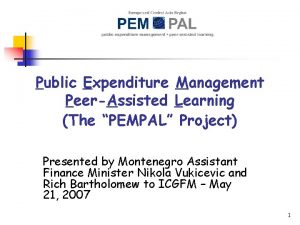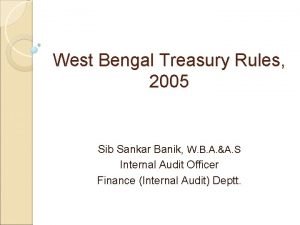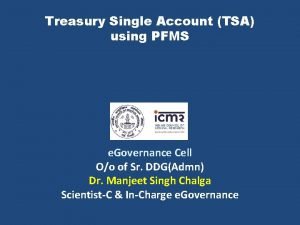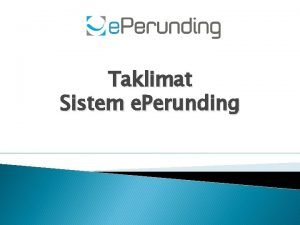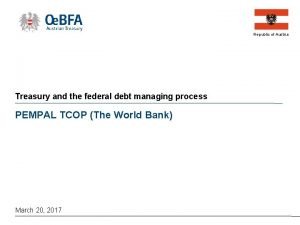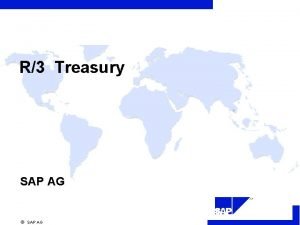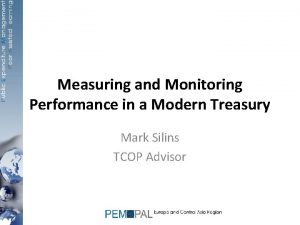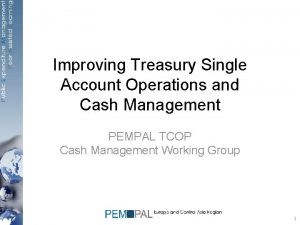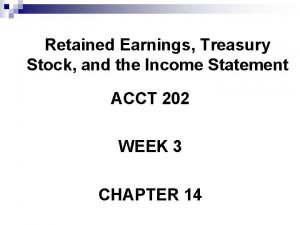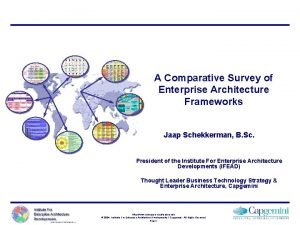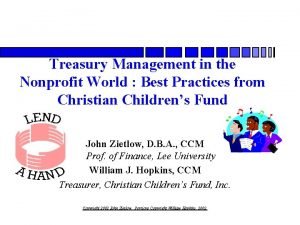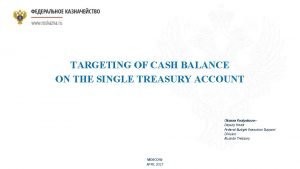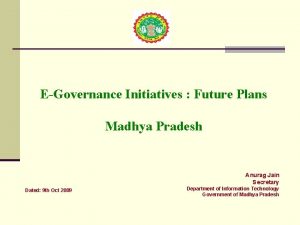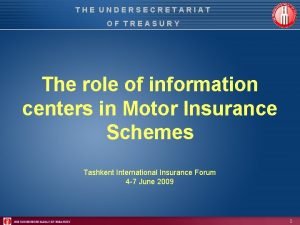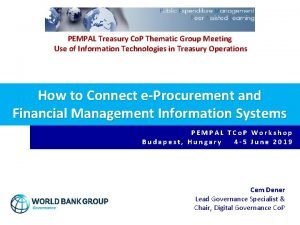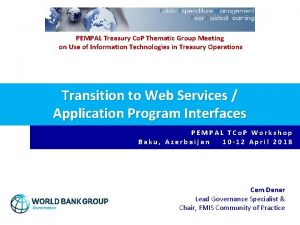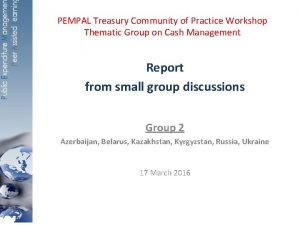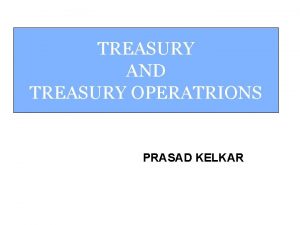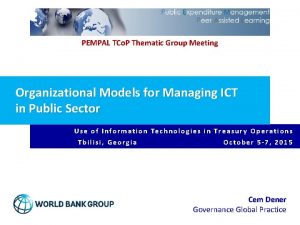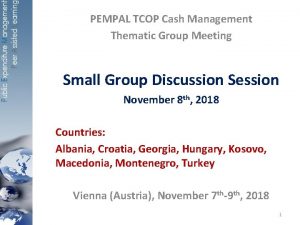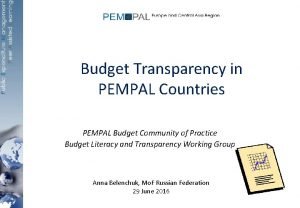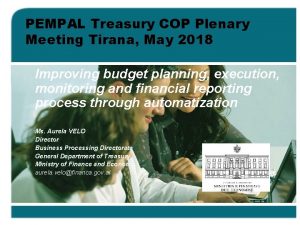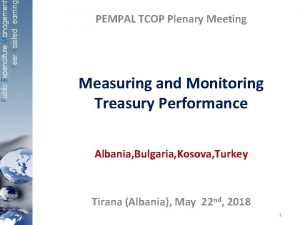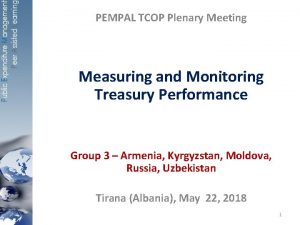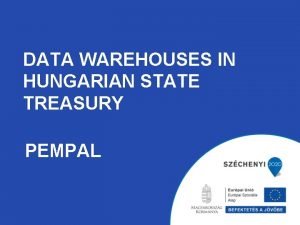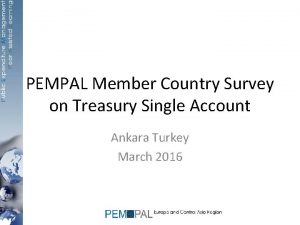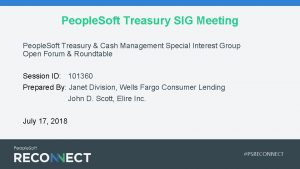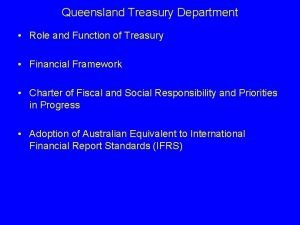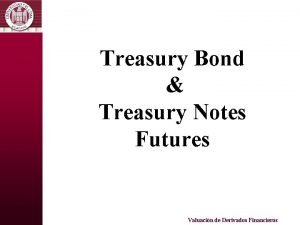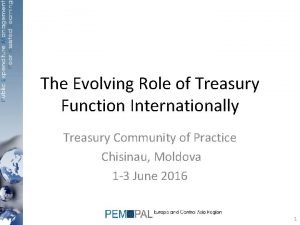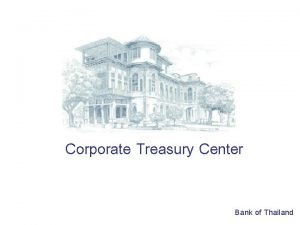PEMPAL Treasury Co P Thematic Group Meeting on




















- Slides: 20

PEMPAL Treasury Co. P Thematic Group Meeting on Use of Information Technologies in Treasury Operations Trends in Expanding the Scope of Financial Management Information Systems PEMPAL TCo. P Workshop Baku, Azerbaijan 10 -12 April 2018 Cem Dener Lead Governance Specialist & Chair, FMIS Community of Practice

Trends in Expanding the Scope of FMIS Contents Transition to IFMIS Trends in Expanding FMIS Scope 1

Transition to IFMIS Core Financial Management Information Systems (FMIS) can be broadly defined as a set of automation solutions that enable governments to plan, execute and monitor the budget. www. worldbank. org/publicfinance/fmis Core FMIS functional modules and interfaces Core FMIS = OLTP IFMIS = OLTP + OLAP Integrated FMIS (or IFMIS) combine core FMIS modules (OLTP) with powerful Data Warehouse (DW) capabilities and multi-dimensional data analysis tools (OLAP) for effective planning, decision support, service delivery, and performance monitoring. 2

IFMIS = OLTP + OLAP Goals > Sustainable public resource management + Effective public service delivery + Open and accountable government Integrated FMIS Solutions Web Portal - Intranet PFM Operational Systems Plan M&E Execute FMIS Audit OLTP T L Other e-Gov E systems OLAP E T L Report • consolidation • slice & dice • drill-down OLTP : Online Transaction Processing G 2 G G 2 E FMIS : Collaboration & Coordination Interfaces DW : Monthly Updates & Dynamic Query Options BI Data Warehouse Account BI DM Open Budget Data DM Multi-dimensional analytical queries Web Portal - Internet FMIS Databases Public Sector Institutions G 2 C G 2 B Citizens, NGOs, Businesses Images: jscreationzs / Free. Digital. Photos. net OLAP : Online Analytical Processing DW: Data Warehouse ETL : Extract, Transform, Load BI : Business Intelligence DM : Data Mining 3

Transition to IFMIS is an Integral Part of Digital Government Integrated Digital Solutions (Government Cloud) FMIS Tax/Cust HRMIS Operational Databases Soc Sec Health Edu System Management Data Center Operations, Help Desk, Disaster Recovery, Information Security & more Data Warehouse (Open Data) Information Management Civil Registration + e-ID Services Functional Registries Institutions G 2 C Citizens G 2 B e-Mail, Content Mgmt, Records/Doc Mgmt, Knowledge Mgmt, Master Data Mgmt & more Shared Services G 2 G G 2 E Businesses e-Payment Services Single Window | One-Stop Shop | Single Sign-on Government Systems * FMIS, Tax, Customs, Health, Education, Social Protection, Pensions & more Public Sector Institutions national, sector and sub-national levels e-Gov Portal & e-Services Digital Signature & PKI Services * Government Systems cover the integration (interconnectivity & interoperability) of sector applications, back office systems, as well as the improvement of institutions, capacity, regulations, processes, information management, and more (National Enterprise Architecture, e-Gov Interoperability Framework, Single Window, and One-Stop-Shops). Society > Citizen Participation & Feedback on e-Services Citizens, NGOs, Businesses A simplified model of integrated Digital Solutions for connected e-Services Images: jscreationzs / Free. Digital. Photos. net 4

Trends and Challenges in Transition www. worldbank. org/publicfinance/fmis to IFMIS Trends Integrating core FMIS with DW and gov systems to improve data quality & value, and to expand the scope of transactions / TSA 2. IFMIS modernization by combining traditional & agile approach 1. 3. Improving interconnectivity through web Application Program Interfaces (APIs), and benefiting from new CC API to link Country Systems with WB databases. Challenges Key challenges in transition to IFMIS are Adaptive (non-technical): • Leadership & change management for transition to digital culture, and improving online service delivery • Enforcing the use of IFMIS for daily recording of all budget transactions, and web publishing of results 5

Trends in Expanding the Scope of FMIS Contents Transition to IFMIS Trends in Expanding FMIS Scope 6

Expansion of FMIS Scope Budgetary Central Government Extra Budgetary Units Social Security Funds State Governments Local Governments Nonfinancial Public Corporations Budget Classification / Chart of Accounts General Government Central Government Nonfinancial Public Sector * How to Automate Recording and Reporting of Public Finance Data? Centralized Database Mo. F > FMIS & DW Interfaces (Web APIs) Distributed Databases other public entities Financial Public Corporations • Financial Monetary Public Corporations (Central Bank) • Financial Nonmonetary Public Corporations * Institutional structure of “Public Sector”, as defined in the IMF Govt Finance Statistics 2001/2014 Manuals 7

Trends in Expansion of FMIS Scope Expansion of FMIS to Support Spending Units Trends in expanding FMIS scope to provide access to Spending Units (SUs) for budgeting, accounting and reporting needs can be broadly categorized in three groups. A combination of these can be seen in many countries depending on the level of transition from fragmented to integrated digital solutions, and operational models (centralized or distributed accounting & reporting). Group Expansion of FMIS to support Spending Units Selected Country Cases* A Centralized web-based shared FMIS providing direct access to all SUs (Public cloud / Internet) Georgia, Estonia B Web Portal linked to centralized FMIS providing (free) access to SUs (Public cloud / Internet) C Distributed & disconnected SU systems exchanging data with centralized FMIS (Interface / Manual) Albania, France, S. Korea, Brazil, Vietnam Moldova, Poland, China * Current status of country cases will be discussed during the workshop for possible updates 8

Trends in Expansion of FMIS Scope FMIS Expansion Options – Pros & Cons A. Centralized web-based shared FMIS providing direct access to all Sus B. Web Portal linked to centralized FMIS providing free access to all SUs Both > Harmonize accounting procedures and reporting standards Both > Unified budget classification/chart of accounts for budget & accounting Both > Require adequate technical capacity & reliable infrastructure to maintain Shared > Can be very expensive (licenses & customization), if FMIS is COTS based Portal > Ideal to lower the cost of FMIS expansion to all SUs Portal > Reduced load on centralized FMIS by supporting selected PFM functions Portal > Can broaden the scope (customized modules), if FMIS is not COTS based C. Distributed & disconnected SU systems (data exchange with FMIS) Least desirable due to excessive cost and system security/reliability concerns • Very difficult to ensure financial data integrity • Data transfer to centralized FMIS is through an interface or manual • Delays in consolidation and verification of transactions, and report generation • 9

Albania > AFMIS Integration Model In Progress AFMIS In Progress Operational since 2010 10

France > CHORUS Integration Model Chorus Forms Shared Services Centre Procurement request Grant request Referrers Chorus Confirmation of Service Provided New V 6 forms creates CENTRAL State Administration Ministries Hospital Administration 16 Territorial Administration Regional Council LOCAL certifies General Council Municipal Council REGIONAL 26 DEPARTMENTAL 100 MUNICIPAL 36 800 EJ* * EJ - Legal commitment SF* SF - Service provided Users in Referrer Depts can issue requests via Chorus Forms portal Source: Jacques MARZIN, CHORUS Presentation, IADB Workshop, Nov 2011 11

PFM Information Systems in Poland > Current Status of PFM Information Systems Local budget exec Ctr budget prep & exec Mo. F WHBP TREZOR = ? ? CU WHBP = ? ? CU BESTIA = ? ? CU Gminas (2, 479) Communes or Municipalities Customs T E-Customs A E-Tax TSA NBP RTGS & ACH T Commercial Banks . . . MDA BESTIA MDA MDA Cust T Online MDA CB #X Br CB #1 Cust Tax MDA Online CB #1 Br Tax MDA Voluntary use SU TREZOR = ? CU BESTIA = 2428 units Online CB #X Online Tax MDA T MDA Cust. . . A Online . . . MDA Offline Interbank Payment Systems T . . . A . . . TREZOR = ? ? CU WHBP = ? ? CU BESTIA = 380 units Tax NBP Tax Cust CB #X Online CB #1. . . ? ? ? BE/PE E-GP Cust . . . Powiat (379) SWEZ-HR . . . Voivodeship (16) BESTIA MDA . . . Offline . . . MDA Central (1) TREZOR = ? ? CU WHBP = ? ? CU BESTIA = 16 units T A Payroll Procurement Pensions Tax CB #1 60, 000 SUs ? ? ? BE/PE TREZOR 3. 0 PPO Wide Area Network ? ? MDAs TREZOR = ? ? CU WHBP = ? ? CU BESTIA = ? units PSC CB #1 CB #X. . . Mo. F CB #X Online SU SU Mo. F : Ministry of Finance MDA : Ministries, Departments, Agencies NBP : National Bank of Poland TSA : Treasury Single Account PSC : Public Service Commission PPO : Public Procurement Office SU T A SU CU : Concurrent User Licenses SU : Spending Unit CB : Commercial Banks WHBP : Data Warehouse (analytics, reporting, monitoring) CB #1 CB #X T Transactional data (Daily, Online) A Aggregate data (Monthly/Quarterly)

Planned Transition to GFMIS in Vietnam Policy Development and Review M-E Budget Preparation Forecasting • Integrated platform • TSA fully operational • New modules: PIM Mgmt of Budget + e-Procurement Authorizations + Debt Mgmt (? ) TABMIS + HRMIS/Payroll Mo. F + Portal for SUs • + SOE reporting Public Investments MPI + Mo. F Audit and Evaluation State Accounting Fiscal Reports & Budget Review GFMIS = B + T (+ O) Mo. F Commitment of Funds TABMIS Mo. F General Ledger Accounting Web Portal / DW Publish / Monitor Daily Operations Debt and Aid Management DMFAS Mo. F Market Operations / Securities Procurement/ Purchasing TABMIS Open Budget Data TABMIS Price Management Mo. F Treasury Single Account Cash Management MPI + Mo. F ITAIS/e-Customs Mo. F Payments and Receipts Mgmt Tax and Customs Asset / Inventory DKTS Mgmt Mo. F HR Mgmt/Payroll + Pensions National Reserves Mo. F + Mo. HA 13

Proposed Integration Model in China > Unified ICT Infrastructure & Online Services Center T SIMIS Tax A Interbank Payment Systems IBPS + HVPS + BEPS PBOC T T PBOC NW AB #1 PBOC Br AB #1 Br Agent Banks AB #X TDC / FC Banks Tax Br PBOC Br . . . TDC / FC Provincial Tax MIS . . . Banks Tax Br DHRSS Tax Br AB #1 Br AB #X Br. . . Provincial HRSS MIS . . . DHRSS AB #X Br T T HRSS TDC Tax Tax AB #1. . . HRSS TDC PBOC. . . HRSS Tax. . . HRSS TDC. . . Town (40, 466) T T Proposed Shared ICT Infrastructure & e-Services . . . County (2, 852) TSA Tax System NW . . . Prefecture (334) FMIS NW SIMIS NW Province (31) Hybrid solution integrating centralized national MIS & provincial MIS platforms T A PBOC Government Service Bus ( Service Oriented Architecture / SOA ) NHFPC NSSF Mo. CA Mo. PS SAIS A SAT PBOC AB #1 AB #X. . . A Mo. F . . . Aggregate (Weekly/Monthly) Transactions ( Daily) Mo. HRSS AB #X AB #1 AB #X Village (704, 386) NHFPC : Nat’l Health & Family Planning Comm NSSF : Nat’l Social Security Fund Mo. CA : Min of Civil Affairs Mo. PS : Min of Public Security SAIS : State Admin for Industry & Commerce 14 DHRSS : Dept. of HRSS TDC / FC : Treasury Disb. Ctr. / Fin. Commissioner Tax Br : Tax Bureau PBOC Br : PBOC Branches AB #X Br : Agent Bank Branches NW : Network

PFM Systems in S. Korea d. Brain > Integrated System Modules Source: d. Brain Presentation; IADB Korean Week in DC, May 2014; Mr. Sang Rock Bae, Director, Mo. SF, S. Korea 15

Trends in Expansion of FMIS Scope Strategic Directions What can be done to define strategic directions for expansion of FMIS? Initiate a stocktaking exercise to clarify the current status of PFM practices, capacity, and information systems in SUs. Discuss possible options for automation of SU PFM functions, and connectivity with centralized systems with key stakeholders: (A) Centralized web-based shared FMIS providing direct access to SUs; (B) Web Portal linked to FMIS providing (free) access to SUs; and (C) Distributed & disconnected SU systems (data exchange with FMIS) Develop a realistic roadmap for the modernization and connectivity of existing/new PFM systems, in line with the expectations of MDAs / SUs Start with pilot implementations to explore the capabilities of webbased solutions (combination of traditional and agile approach) 16

Thank you FMIS Co. P > https: //e. Team. worldbank. org/FMIS Web Site > http: //www. worldbank. org/publicfinance/fmis

Web Resources > FMIS Co. P www. worldbank. org/publicfinance/fmis FMIS Community of Practice Objective : To assist the practitioners (country clients, World Bank staff/consultants, and development partners) in improving the effectiveness of PFM operations and service delivery by sharing knowledge and experiences, and producing relevant, leading edge knowledge products on integrated FMIS solutions. Established in Sep 2010. Around 1, 250+ members from 135 economies (as of Mar’ 18). https: //e. Team. worldbank. org/FMIS

Web Resources www. worldbank. org/publicfinance/fmis WBG developed several global datasets to present the current status of Public Financial Management (PFM) information systems, Open Budget Data (OBD) practices, and e-Services in 198 economies, as well as the WBG funded FMIS and Digital Governance projects: FMIS Projects Database https: //datacatalog. worldbank. org/dataset/financial-management-information-systems-database Details of 140+ WBG projects in 79 countries (since 1984). Released in Aug 2010. Updated biannually (Jan + Aug). FMIS & OBD Global Dataset https: //datacatalog. worldbank. org/dataset/fmis-and-open-budget-data-global-dataset Practices in publishing Open Budget Data from FMIS in 198 economies. Released in Sep 2013. Updated annually (Aug). PFM Systems & e. Services Dataset https: //datacatalog. worldbank. org/dataset/public-financial-management-systems-and-eservices-global-dataset Global dataset on PFM systems & e. Services in 198 economies. Released in Mar 2015. Updated annually (Aug). Digital Governance Projects Database https: //datacatalog. worldbank. org/dataset/digital-governance-projects-database 1, 200+ digital governance projects in 150+ countries (since 1995). Released in Jun 2015. Updated annually (Aug). ID 4 D Global Dataset https: //datacatalog. worldbank. org/dataset/identification-development-global-dataset Civil registration & identification systems in 198 economies. Released in Dec 2014. Updated annually.
 Pempal
Pempal Thematic statement def
Thematic statement def For today's meeting
For today's meeting Meeting objective
Meeting objective What is meeting and types of meeting
What is meeting and types of meeting What is meeting and types of meeting
What is meeting and types of meeting Treasury rules 2005
Treasury rules 2005 Treasury
Treasury Treasury single account pfms
Treasury single account pfms Eperunding treasury
Eperunding treasury Treasury report example
Treasury report example Sap treasury workstation
Sap treasury workstation Treasury kpi metrics
Treasury kpi metrics Features of treasury single account
Features of treasury single account Fxall settlement center
Fxall settlement center Treasury stock income statement
Treasury stock income statement Treasury enterprise architecture framework
Treasury enterprise architecture framework Treasury management best practices
Treasury management best practices Treasury cash balance
Treasury cash balance Cyber treasury mponline
Cyber treasury mponline Undersecretariat of treasury (turkey)
Undersecretariat of treasury (turkey)
